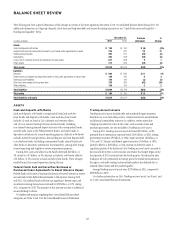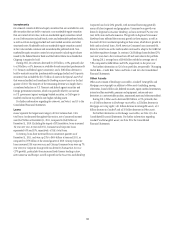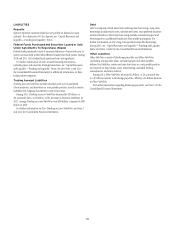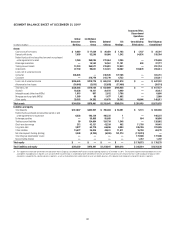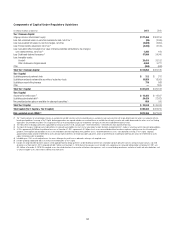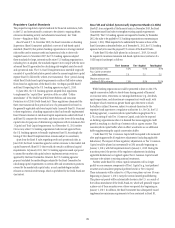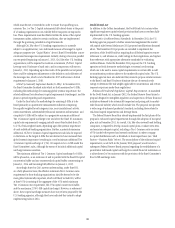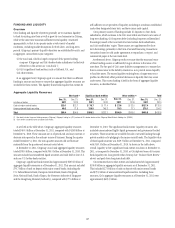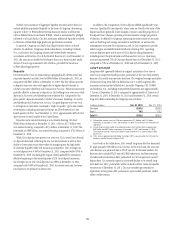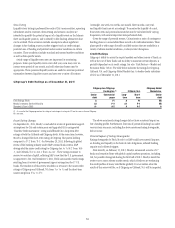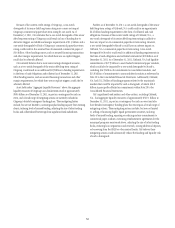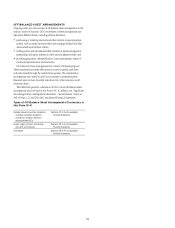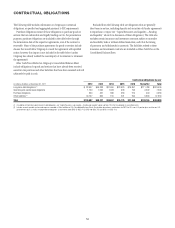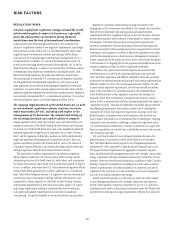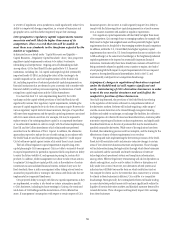Citibank 2011 Annual Report Download - page 68
Download and view the complete annual report
Please find page 68 of the 2011 Citibank annual report below. You can navigate through the pages in the report by either clicking on the pages listed below, or by using the keyword search tool below to find specific information within the annual report.46
which must be met or exceeded in order to ensure that qualifying non-
common Tier 1 or Tier 2 Capital instruments fully absorb losses at the point
of a banking organization’s non-viability before taxpayers are exposed to
loss. These requirements must be reflected within the terms of the capital
instruments unless, subject to certain conditions, they are implemented
through the governing jurisdiction’s legal framework.
Although Citi, like other U.S. banking organizations, is currently
subject to a supplementary, non-risk-based measure of leverage for capital
adequacy purposes (see “Capital Ratios” above), Basel III establishes a more
constrained Leverage ratio requirement. Initially, during a four-year parallel
run test period beginning on January 1, 2013, Citi, like other U.S. banking
organizations, will be required to maintain a minimum 3% Tier 1 Capital
Leverage ratio. Disclosure of such ratio, and its components, will start on
January 1, 2015. Depending upon the results of the parallel run test period,
there could be subsequent adjustments to the definition and calibration of
the Leverage ratio, which is to be finalized in 2017 and become a formal
requirement by January 1, 2018.
Global Systemically Important Banks (G-SIBs). In November 2011,
the Basel Committee finalized rules which set forth measures for G-SIBs,
including the methodology for assessing global systemic importance, the
related additional loss absorbency capital requirements (surcharges), and the
phase-in period regarding such requirements.
Under the final rules, the methodology for assessing G-SIBs is to be
based primarily on quantitative measurement indicators comprising
five equally weighted broad categories: size, cross-jurisdictional activity,
interconnectedness, substitutability/financial institution infrastructure, and
complexity. G-SIBs will be subject to a progressive minimum additional
Tier 1 Common Capital surcharge (over and above the Basel III minimum
capital ratio requirements) ranging initially across four buckets from 1%
to 2.5% of risk-weighted assets, depending upon the systemic importance
of each individual banking organization. Further, a potential minimum
additional 1% Tier 1 Common Capital requirement could also be imposed
in the future on the largest G-SIBs that are deemed to have increased their
global systemic importance (resulting in a total minimum additional Tier
1 Common Capital surcharge of 3.5%). Citi expects to be a G-SIB under the
Basel Committee’s rules, although the extent of its initial additional capital
surcharge remains uncertain.
The minimum additional Tier 1 Common Capital surcharge for G-SIBs
will be phased-in, as an extension of and in parallel with the Basel III capital
conservation buffer and any countercyclical capital buffer, commencing on
January 1, 2016 and becoming fully effective on January 1, 2019.
Accordingly, based on Citi’s current understanding, under Basel III,
on a fully phased-in basis, the effective minimum Tier 1 Common ratio
requirement for those banking organizations initially deemed to be the
most global systemically important, which will likely include Citi, will be
at least 9.5% (consisting of the aggregate of the 4.5% stated minimum
Tier 1 Common ratio requirement, the 2.5% capital conservation buffer,
and the maximum 2.5% G-SIB capital surcharge). However, as referenced
above, these capital surcharge measures have not yet been proposed by the
U.S. banking agencies, although they have indicated they intend to adopt
implementing rules in 2014.
Dodd-Frank Act
In addition to the Collins Amendment, the Dodd-Frank Act contains other
significant regulatory capital-related provisions that have not yet been fully
implemented by the U.S. banking agencies.
Alternative Creditworthiness Standards. In December 2011, the U.S
banking agencies proposed to further amend and supplement the market
risk capital rules beyond the January 2011 proposed modifications discussed
above. The December 2011 proposals are intended to implement the
provisions of the Dodd-Frank Act requiring that all federal agencies remove
references to, and reliance on, credit ratings in their regulations, and replace
these references with appropriate alternative standards for evaluating
creditworthiness. Under the December 2011 proposal, the U.S. banking
agencies set forth alternative methodologies to external credit ratings
which are to be used to assess capital requirements on certain debt as well
as securitization positions subject to the market risk capital rules. The U.S.
banking agencies have also indicated they intend to propose similar revisions
to the Basel I and Basel II rules to eliminate the use of external credit
ratings to determine the risk weights applicable to securitization and certain
corporate exposures under these regulations.
Enhanced Prudential Regulatory Capital Requirements. As mandated
by the Dodd-Frank Act, in January 2012, the Federal Reserve Board issued a
proposal designed to strengthen regulation and supervision of those financial
institutions deemed to be systemically important and posing risk to market-
wide financial stability, which would include Citi. The proposal incorporates
a wide range of enhanced prudential standards, including those related to
risk-based capital requirements and leverage limits.
The Federal Reserve Board has already implemented the first phase of the
proposal’s enhanced capital requirements through the adoption of its capital
plan rule in December 2011. As a result, Citi, like other covered bank holding
companies, is required to develop annual capital plans, conduct stress tests,
and maintain adequate capital, including a Tier 1 Common ratio in excess
of 5% (under both expected and stressed conditions) in order to engage
in capital distributions such as dividends or share repurchases (see “Risk
Factors—Business Risks” below). The second phase of the enhanced capital
requirements, as set forth in the January 2012 proposal, would involve a
subsequent Federal Reserve Board proposal regarding the establishment of a
quantitative risk-based capital surcharge for covered financial institutions or
a subset thereof, to be consistent with the provisions of the Basel Committee’s
final G-SIB surcharge rules.



